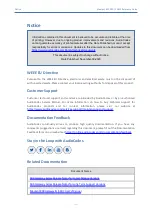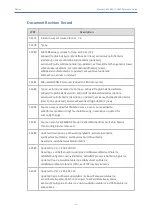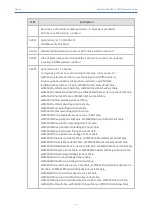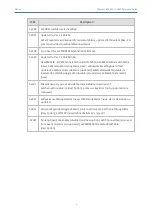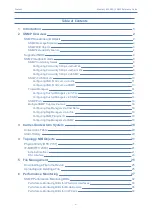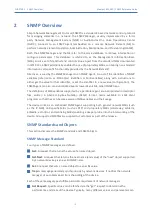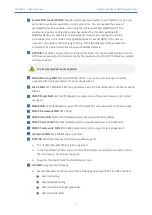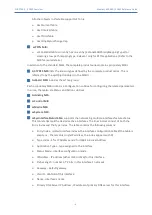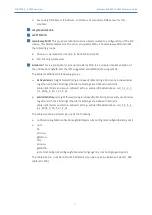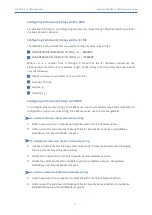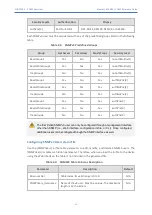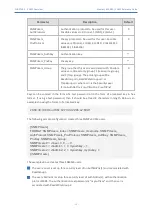
CHAPTER 2 SNMP Overview
Mediant 800 SBC | SNMP Reference Guide
2
SNMP Overview
Simple Network Management Protocol (SNMP) is a standards-based network control protocol
for managing elements in a network. The SNMP Manager, usually implemented by a third-
party Network Management System (NMS) or AudioCodes One Voice Operations Center
(OVOC), connects to an SNMP Agent (embedded on a remote Network Element (NE) to
perform network element Operation, Administration, Maintenance, and Provisioning (OAMP).
Both the SNMP Manager and the NE refer to the same database to retrieve information or
configure parameters. This database is referred to as the Management Information Base
(MIB), and is a set of statistical and control values. Apart from the standard MIBs documented
in IETF RFCs, SNMP additionally enables the use of proprietary MIBs, containing non-standard
information set (specific functionality provided by the Network Element).
Directives, issued by the SNMP Manager to an SNMP Agent, consist of the identifiers of SNMP
variables (referred to as MIB object identifiers or MIB variables) along with instructions to
either get the value for that identifier, or set the identifier to a new value (configuration). The
SNMP Agent can also send unsolicited events towards an EMS, called SNMP traps.
The definitions of MIB variables supported by a particular agent are incorporated in descriptor
files, written in Abstract Syntax Notation (ASN.1) format, made available to EMS client
programs so that they can become aware of MIB variables and their usage.
The device contains an embedded SNMP Agent supporting both general network MIBs (such
as the IP MIB), VoP-specific MIBs (such as RTP) and proprietary MIBs (acGateway, acAlarm,
acMedia, acControl, and acAnalog MIBs) enabling a deeper probe into the interworking of the
device. All supported MIB files are supplied to customers as part of the release.
SNMP Standards and Objects
This section discusses the SNMP standards and SNMP objects.
SNMP Message Standard
Four types of SNMP messages are defined:
■
Get:
A request that returns the value of a named object.
■
Get-Next:
A request that returns the next name (and value) of the "next" object supported
by a network device given a valid SNMP name.
■
Set:
A request that sets a named object to a specific value.
■
Trap:
A message generated asynchronously by network devices. It notifies the network
manager of a problem apart from the polling of the device.
Each of these message types fulfills a particular requirement of network managers:
■
Get Request:
Specific values can be fetched via the "get" request to determine the
performance and state of the device. Typically, many different values and parameters can
- 2 -


